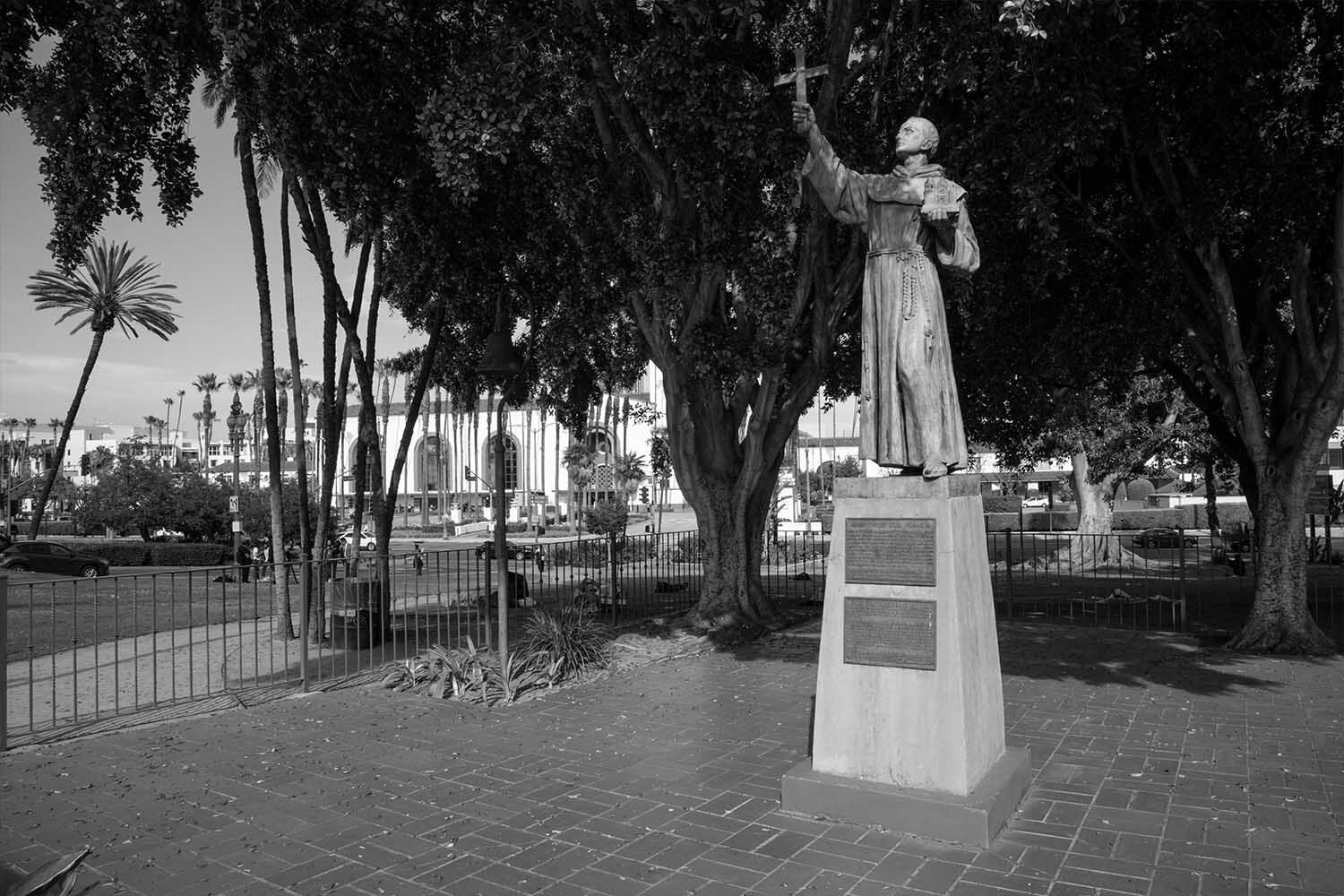I have written posts before about how Garry Winogrand is my favorite photographer. I saw his MoMA retrospective in 1988, his SFMoMA retrospective, the entire Women are Beautiful exhibition at Pier 24 and my library has lots of Winogrand books. One of my favorite books is John Szarkowski’s “Winogrand - Figments from the Real World”, and it was that book which led me to me to photograph the Father Serra statue pictured above.
I have gone through the book many times over the years, and early on I found something intriguing. That both Winogrand and Robert Frank had photographed the same Father Serra statue in Los Angeles in 1955. Neither of them knew one another but both stumbled on to this same statue, in the same year, while exploring America, and independent of one another. A statue that wasn’t famous and was in an unassuming part of Los Angeles. Below are their images from Szarkowski’s book.
Back then I decided that I also wanted to photograph the statue, maybe as a right of passage as a photographer, maybe just out of interest to see how my image would compare to their images. Using the two images I had a good idea where the statue was and I decided to photograph it on my mom’s birthday, May 29th, in 1995. I had a feeling it might become an important photograph for me so I chose a memorable date, and there was no rush since the statue wasn’t going anywhere. On the way home from Pasadena, after seeing my mom, I headed to Sunset to photograph the statue. When I got there not only was the statue not there, that part of Sunset Boulevard had been renamed and the streets were reconfigured. I got out my Thomas Brothers map (iPhones and mobile internet access did not exist yet) and began searching. After driving around for a few minutes I located the statue a couple blocks away in what is now called Father Serra Park at N. Alameda and Los Angeles Street, across from Union Station. Having a new location my background options were completely different. I decided on photographing the statue from behind, looking West, with the sun creating a good silhouette of the cross. I included a couple palm trees to frame it and the 110 Freeway on ramp sign because it said “Pasadena” & “Hollywood” on it. I actually liked my image better than theirs, and a print hangs in my house still (CA - 087 #17).
For whatever reason I started thinking about this image in this past May and wondered how long ago I had photographed it. I checked, it was in 1995, and I then realized 2020 was the 25th Anniversary. I decided to photograph the statue again on my mom’s birthday. On May 29th my son and I headed to Los Angeles on the way to Pasadena. We parked at Union Station, masked up, and headed over to photograph Father Serra.
The palm trees were gone and the tree behind it had grown so much it engulfed the statue. The freeway sign had been moved and there was now a fence around the statue area, I assume to keep the homeless from camping under it. I tried all the angles above and I think the image with Los Angeles City Hall in the background was the best image now.
As I was finishing up we heard sirens, lots of them, and saw several news helicopters South of us. We began walking towards City Hall and saw multiple LAPD patrol cars headed to City Hall and LAPD’s Headquarters, the George Floyd Protests of Los Angeles were beginning.
I photographed some in the area and found the protesters were much farther South and moving away from us. They were attempting to take over LA Live and Staples Center. Because of the distance and not knowing the situation down there we headed back to the car and went to see my mom.
As we all know the protests and civil unrest have continued, and have expanded to encompass so many more things. On June 20th , sixty indigenous activists used the current climate to stage a protest at the Father Serra statue, The activists invited the Los Angeles Times to come document the Father Serra statue being toppled and the Times accepted. The activists pulled the statue down in a ceremony, poured red paint on the head, spray painted “ACAB” (All Cops Are Bastards) on the torso, and cut the cross from his hand. They left the statue afterward but kept the cross as symbolic souvenir I assume. I have no idea how they linked the anti police narrative to Father Serra but I guess it made sense to someone with a can of spray paint.
25 Days after had I re-photographed the Father Serra statue (my 25th Anniversary of photographing it) I returned and photographed the empty pedestal.
This man saw me photographing where the statue had been and came over to start a conversation and take his own photographs. He said as a kid he had gotten in trouble at school for talking about Father Serra’s atrocities against indigenous people instead of talking about how the missions helped to develop California. No idea if that was true but he was polite enough and I have absolutely no problem with his viewpoint. I respect his argument and I was not here in the 1700’s to see first hand what the conditions were like at the Missions.
What I do have a problem with is 60 people deciding to destroy something that belongs to an entire community of millions of Angelinos . We can not accept acts such as this to be considered an exercise of one’s “freedom of speech” if we are to maintain a Democratic society. If the activists wanted to petition for an Indigenous Statue to be placed next to the Father Serra statue to tell the full story, great!, I would support that 100%. If the public display of the likeness of a man who died 236 years ago is hurtful to the majority of the community, and the community decides to have the statue removed to a secluded place where it won’t offend people, then I am fine with that too. I am also not writing about this to defend Father Serra or the Catholic Church, nor to criticize people who exercise their First Amendment Right appropriately. But you can’t destroy history, no one rights any wrongs with toppling a monument. In this case, for me as a photographer, that statue had so much more meaning than the person it depicted because of the people who have photographed it. Its gone now, and what gain did that group get besides a brief moment in the news spotlight which has already faded, especially in today’s world of constant conflict and health worries.


















